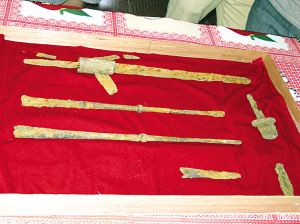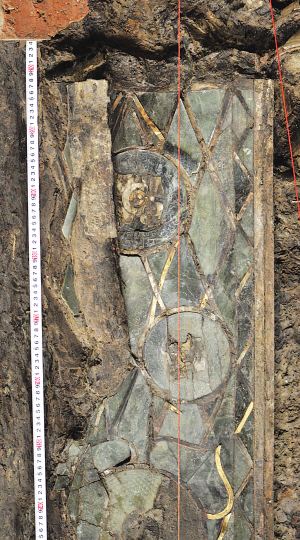A Cluster of Ancient Han cemetery Excavated at Xuyi, Jiangsu
The archaeological survey and excavation by the Institute of Archaeology (Nanjing Museum) for the past ten months have revealed a large cluster of Western Han cemetery at the summit of Mt. Dayun (Yunshan Village, Maba Town, Xuyi County, Jiangsu). Inside the graveyard have been found three large tombs, two arsenal pits, one chariot and horse pit, and thirteen satellite tombs of varied ranks. The graveyard, measuring two hundred and fifty thousand square meters, is one of the rare examples of the high rank archaeological finds in the history of excavation by the Nanjing Museum.

The Institute began the survey in Mid-February and the excavation in September. It turns out to be a large scale cemetery consisting of several vertical tombs with multiple coffins. Including constituent elements such as graveyard walls, gates, and architecture above the tombs, the cemetery ought to be built for some high-rank people.

The fragmentary state of the wood coffin planks as well as traces of burnt planks indicates that Tomb No. 1 had been several times robbed, probably during the Eastern Han and the Tang-Song period. Thirteen meters from Tomb No. 1, Tomb No. 2 is also a tomb with double ramps at north and south ends. Inside that tomb have been discovered a jade shroud and a jade coffin. Gold thread connecting the jade pieces have been well preserved to the extent that the details of how the gold thread is tied to the pieces can be clearly observed. Such cases were found in situ inside the tomb.

At least one side wall of the jade coffin can be used to clarify the way the coffin was decorated. Its surface is inlaid with plenty of diamond-shaped jade pieces, in between which are jade bi disks with surface designs. The jade pieces are framed with gold as well as silver leaves. The surface of the jade disks is pasted with silver leaves. The lights that emit from jade, gold, and silver give the entire coffin a brilliant aura. The coffin planks are covered with gold leaves with jade inlaid. Up to now, similar cases can only been found in the Han tombs at Mancheng (Hebai) and Shizishan (Xuzhou).
Despite the fact that the tomb had been severely robbed, the jade coffin itself is so intact that it can be counted as the best preserved Han jade coffin ever discovered. Thus, it provides some valuable information not only for reconstructing the funerary usage of jade in the Han in general but also for resolving some specific puzzles such as how the jade leaves were attached to the inner walls of the lacquer coffins.
Now it can be positively said that the area at the summit of Mt. Dayun was a cemetery of high rank tombs during the Han dynasty. Each side of the cemetery measures approximately five hundred meters, showing a rough square in shape. From those satellite tombs have been unearthed plenty of burial objects, including glazed pottery pots, bronze fang objects, bronze mirrors, iron stoves, lacquer toiletries, lacquer “ear cups”, jade cicadas, and jade hooks, among others. In addition, some pottery shards carved with the Chinese graphs dongyang东阳 have also been discovered from those tombs. (Translated by Wang Yudong)

